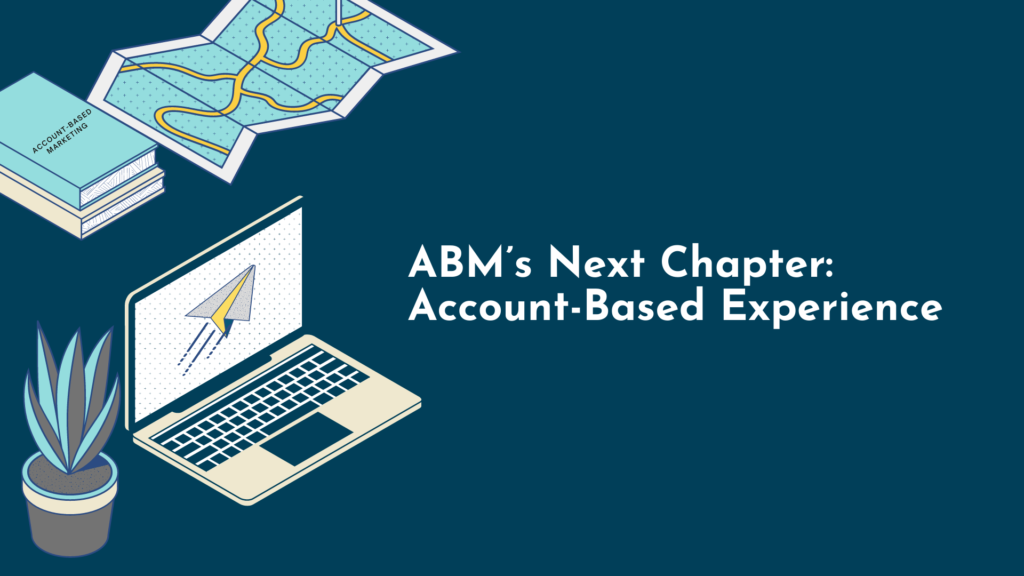Account-based marketing (ABM) is been one of the popular marketing strategies and has revolutionized how revenue generation teams got to market. With the continuous evolution happening in the ABM space, organizations need to be au courant. With a lot of buzz going around Account-Based Experience (ABX), many believe that it is going to be the way forward. Simply put, Account-Based Experience (ABX) is what a successful ABM looks like in practice.
From Account-based marketing to Account-based experience
The pandemic has forced B2B sales leaders and marketers to rewrite their sales and marketing playbooks. Using the same old tactics and hoping to get an exceptional outcome might not be an ideal scenario. That is why ABM being one of the best marketing strategies out there is also evolving. While the customer segmentation provided by ABM allows being more relevant and efficient, it requires the whole organization to shift the mindset and build programs that encompass segmentation across pipeline development, sales, and customer success.
ABM is wonderful and has proven to be a highly effective marketing strategy. ABM relies on engaging with hand-picked target accounts and pursuing them relentlessly, with little regard for whether they want to be pursued at all. In a typical ABM program, sales focused on identifying valuable accounts and while engaging with them, regardless of whether the time was right or if they were interested to hear from them. Along this process, the marketing team gets involved as well.
Looking at it from the buyers’ perspective, buyers today prefer to research products and services at their convenience. They will not engage with the vendor unless they have adequate information already. B2B people have become more selective with whom they speak to, it has rather become more about the “trust factor”. Because of this, ABX is gaining popularity as it fully integrates marketing, sales, and customer success to create a cohesive customer experience.
As per a report by Accenture, “Most B2B buyers are already 57% of the way through the buying process before the first meeting with a representative.”
While ABM exhibits the marketing avenue of account-level customer experience and engagement, ABX is the outcome of combined sales and marketing efforts. ABX is a synchronized and ceaseless customer experience that focuses on the lifetime value of a specific account and adds up to a larger, holistic, and long-term customer relationship.
Let’s begin by understanding what Account-Based Experience (ABX) is
Account-based Experience is a customer-centric marketing strategy. It is putting the customer at the center of everything you do while being relevant. It is all about engaging buyers with relevant messages, delivered to them via a trusted channel, on their terms.
According to Demandbase. “Account-Based Experience (ABX) is a go-to-market strategy that uses data and insights to orchestrate relevant, trusted marketing and sales actions throughout the B2B customer lifecycle.”
ABX focuses more on the experiential side of things and comes more from the buyer-centric viewpoint. It will only be fair to say that ABX is like a secret sauce that helps to generate revenue faster in comparison to any ABM program. ABX is a shift in mindset: from sales orientation to focusing more on the customer. ABX applies the same ideas that underpin a great customer experience – trust, empathy, and relevance – to the account-based world.
The B2B space is trying to break down silos over the past few years, trying to get everyone in the organization join the bandwagon. ABX takes the best ABM practices and applies them across the customer experience. ABX improves every aspect of the buyer experience throughout the B2B lifecycle, outperforming traditional demand generation and ABM. Moreover, ABX ensures that all of the different interaction points for the customer is almost seamless.
Why does account-based experience (ABX) matter?
Similar to ABM, ABX sells to the account, meaning reaching out to everyone in the buying team. Different aspects like revenue, customer retention, and satisfaction all depends on the experience buyers get. ABX is all about being helpful and relevant when the buyers are ready to interact with you and are based on trust. But, reaching out to buyers at the right time is always a challenge. ABX uses artificial intelligence to identify buyers when they show intent and engagement across first and third-party platforms. ABX also helps to orchestrate the right experience for buyers during each step of their buying journey.
Segmentation of an ABX approach
ABX segments account in a similar way that ABM does. The only difference ABX has is: it ensures unity across all departments when implementing different tactics.
Top: 1-to-1
In this approach, we market to identified accounts in a highly personalized manner. Creating personalised landing pages, building-specific content or launching dedicated campaigns are some of the ways to build engagement on a 1-to-1 basis.
Middle: 1-to-few
In this approach, we identify a segment of accounts based on industry or region they operate in and target them using different marketing tactics. Targeting can be done either by launching marketing campaigns or drafting messages that resonate with the target accounts better. For instance: a campaign can be planned to target the top 10 players in the SaaS companies in the UK, and different tactics such as targeted email marketing campaigns, LinkedIn advertising can be planned.
Bottom: 1-to-many
In this approach, a broad set of accounts are targeted, with the help of different marketing platforms. The number of target accounts could be more than 100 and it is not possible to launch personalised campaigns, rather programmatic advertising is done.
How Insight can power account-based Experience (ABX)?
Businesses no longer compete with each other on product or price, but with experience. Experience has become the new currency. No matter the experience is online or offline, buyers seek seamless interaction. One of the essential aspects of ABX is knowing the right time to engage with buyers through helpful and relevant content across channels.
Developing account insights
The success of ABX relies on understanding the accounts. To cut through the crowd, it is crucial to have a deep knowledge of the account’s industry, their pertaining issues, and opportunity areas for them. Insights will help in maximizing relevance and resonance within each account. Account insights is a combination of firmographic and technographic data. Every account insight must try to uncover information about the industry the account operates in, business priorities and challenges, technology landscape, information about key competitors, recent acquisitions and divestitures, financial standing, and other valuable pieces of information.
- What is the industry they are in?
- How big is the account? What is the revenue?
- How is technology evolving, trends and competitors influencing their business?
- What are the business challenges and opportunities?
- How does the organizational chart look like?
One of the best and effective ways to gather insight is through desk research. Technology cannot interpret information in a way a human can. Information like market dynamics, news, trend, and growth drivers require human intelligence for information gathering. Collecting information such as top priorities, business strategy, strengths, weaknesses, opportunities and threats; their culture and values; their competitors and partners; their unique buying centres will help in building a true understanding of the target accounts.
Developing buyer persona insights
We have been talking a lot about how buyers are the ones who will make purchase decisions and not accounts. In that sense, it makes it even more important to build buyer persona insights. Buyer persona insights can be better understood as intel on different roles within the buying committee. Information about buyers’ priority areas, challenges, preferences, goals and interests, and their previous work experience are crucial for building personas. Building buyer personas will help them personalise their messaging to individuals within the buying team at each stage of the buyer’s journey.
- What is their role in the organisation and in buying decisions?
- What is their decision-making style? For example, do they approach things from a rational mindset or emotional mindset?
Creating personalised content
Once all the insight has been gathered, it is now time to put it to work. Building content and targeted messaging for different touchpoints help to offer exceptional experiences to the buyers.

| Built just for this particular account and persona | Created for multiple personas at a single target account | Building content for one account | Content targeted for industry-specific accounts | Content for all targets, yet relevant to the account |
After you have a strong understanding of your buyer personas, it becomes easy to build a customised experience. When experience is at the center of your ABM strategy, it brings sales, marketing and customer services teams together by breaking notions of buyer stage ownership, and provides clarity to the customer lifecycle.
Conclusion
Account-based experience (ABX) leads not only to high-quality content but also to a higher ROI. ABX requires the unification of the organization’s revenue teams, including marketing, sales and customer success. ABX pushes ABM to the next level by incorporating intent data to identify cross-sell and upsell opportunities. Hence, ABX provides sales and marketing the ability to provide unrivaled unique experiences through consistent, personalized, and relevant messaging. ABX is about focusing on the entire customer journey and creating a lifelong business partnership. If you apply your ABX strategies correctly you may never lose a client.


